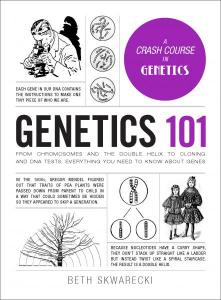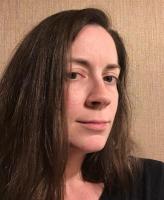Beth Skwarecki, Genetics 101
For this column, NASW book editor Lynne Lamberg asks NASW authors to tell how they came up with the idea for their book, developed a proposal, found an agent and publisher, funded and conducted research, and put the book together. She also asks what they wish they had known before they began working on their book, what they might do differently the next time, and what tips they can offer aspiring authors. She then edits the A part of that Q&A to produce the author reports you see here.
Publication of NASW members’ reports in Advance Copy does not constitute NASW’s endorsement of their books. NASW welcomes your comments, and hopes this column stimulates productive discussions.
GENETICS 101:
FROM CHROMOSOMES AND THE DOUBLE HELIX
TO CLONING AND DNA TESTS,
EVERYTHING YOU NEED TO KNOW ABOUT GENES
(SERIES: ADAMS 101)
Beth Skwarecki
Adams Media, July 17, 2018, $15.99
ISBN-10: 1507207646; ISBN-13: 978-1507207642
Skwarecki reports:
Two years ago I wrote a book about disease epidemics through history (Outbreak!) and not long ago my editor from that project asked if I could write a book about genetics for the lay reader. That’s how Genetics 101 was born.
Even though I majored in biology in college, and use a working knowledge of genetics and molecular biology in my day-to-day reporting (I write about health at Lifehacker), to do this topic justice, I had to get my hands on up-to-date textbooks and find out what’s going on in the world of personal genomics. I worked through a circa-2013 online course on genetics presented by 23andMe, which not only helped me brush up but also provided food for thought on how to organize a genetics course when one doesn’t have to meet any particular school’s syllabus requirements.
I’ve taught biology before, so I have plenty of opinions on what material is most confusing and most useful. I started with the difference between atoms and molecules, talked about DNA’s shape and function, and toured cell biology (including transcription and translation) while using as many real-life examples as I could. Mendel didn’t get his shout-out until about halfway through the book, by which point readers understand what must have been going on inside those pea plants to give him the results that he saw.Then I got to move on to more exciting, modern, and controversial topics: race, ethnicity, ancestry, evolution, cancer genetics, genetically modified crops, and gene editing, to name a few. It’s essentially a textbook with all the boring parts removed or glossed over, with a goal of helping readers understand things they read about in the news or a personal genomics test report.
This book was done on a tight deadline, and I’m glad I learned from previous projects how important it is to budget my time. I gave myself mini deadlines for each group of chapters, and carved out writing time every evening. I did that calculation before I signed my contract to write the book, and made sure to negotiate more room in the deadlines.
Contact info:
- Beth Skwarecki, 412-465-0462, beth@bethskw.com, bethskw.com
- Book website: http://www.simonandschuster.com/books/Genetics-101/Beth-Skwarecki/Adams-101/9781507207642
- Publicist: Bethany Carland, 508-205-1607, bethany.carland-adams@simonandschuster.com
NASW members: will your book be published soon? Take advantage of this opportunity for shameless self-promotion. Submit your report for Advance Copy.
Tell your fellow NASW members how you came up with the idea for your book, developed a proposal, found an agent and publisher, funded and conducted research, and put the book together. Include what you wish you had known before you began working on your book, or had done differently.
See https://www.nasw.org/advance-copy-submission-guidelines.
Thinking of writing a book? If you are a NASW member, you may access a list of more than 150 books and online resources to help you craft your book proposal, find an agent and funding sources, negotiate your contract, learn about self-publishing, publicize and market your book, and more at https://www.nasw.org/article/write-book.
Send book info and questions about book publishing to Lynne Lamberg, NASW book editor, llamberg@nasw.org.


